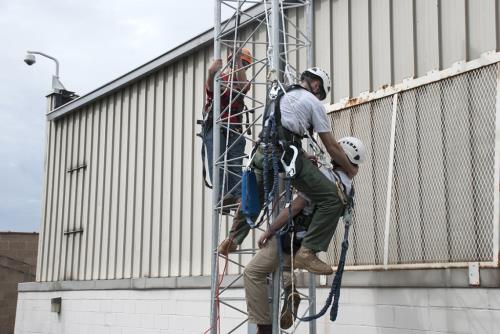 ElectricalConnection.org
ElectricalConnection.org
Connect with Us:
Facebook
LinkedIn
Twitter
YouTube
Cell tower safety and rescue training at the 
IBEW/NECA Electrical Industry Training Center.
ST. LOUIS — With the proliferation of mobile communications, including an estimated 1.3 billion smart phones sold in 2014, comes a challenge for the construction industry — safely constructing and maintaining a growing network of cell towers. To meet the challenge, the IBEW/NECA Electrical Industry Training Center in St. Louis began offering cell tower safety and rescue training that includes a 25-foot tall tower on the site of the training center at 2300 Hampton Ave. The training center is jointly operated by the International Brotherhood of Electrical Workers (IBEW) Local One and the St. Louis Chapter of the National Electrical Contractors Association (NECA).
Climbing cell towers to install, repair or upgrade electrical systems and transmitters is one of the most dangerous jobs in construction. With some towers soaring more than 600 feet, falls have resulted in nearly 100 deaths since 2003, a rate that is 10 times the average for the construction industry according to a 2012 report by PBS’ Frontline.
“Our training program is geared toward the best safety practices, including the very difficult task of rescuing a co-worker who has become incapacitated on a tower,” said Dennis Gralike, director, Electrical Industry Training Center. “It takes a lot of skill to get an unconscious worker down hundreds of feet safely to first responders. Time is of the essence, but so is a safe descent.”
The training program is led by instructor Garrett Biermann, who has safely climbed approximately 400 towers over the past two years. He is a certified authorized climber and tower rescue and competent climber and has completed the “train the trainer” program offered by the Communication Industry Training and Certification Academy (CITCA) in Kankakee, Ill. “Police and fire first responders don’t have this specialized training, so we really need the skills to rescue our fellow workers,” said Biermann. “You can’t be complacent up there. Even if you fall but are saved by being tied to the structure, you can become unconscious and your co-workers would need to get you down safely within 15 to 45 minutes to first responders or you could lose your life.“
The program curriculum includes instruction to become a competent climber and rescue training. It includes instruction on proper rigging of lanyards and harnesses, safety rules for climbers, working as a team to ensure a safe climb, stabilizing an injured worker and rescue techniques. In all, the program totals 32 hours of training to earn tower climbing rescue certification, which must be renewed every two years.
“It’s tough physical work, but many in our workforce already have extensive experience climbing power plant smokestacks and other tall industrial structures,” said Frank Jacobs, business manager, IBEW Local One. “This allows us to provide enhanced safety and rescue training for not only cell towers, but all projects where work has to be performed at significant heights. We will train as many IBEW journey workers as the industry needs to meet demand for the work.”
According to the Wireless Estimator, a website that tracks communications tower industry news, there are more than 100,000 cell towers in the U.S. and more than 2,500 in Missouri. Over the past decade, not only have new towers been built, but carrier investment in upgrades, including the latest 4G network systems, have created a significant demand for work on towers.
The training center is working with PayneCrest Electric, JF Electric and other NECA contractors to develop tower construction and maintenance services. “Our contractors want to be ready to fulfill the needs of communication industry carriers who must build and maintain a growing number of cell towers to meet the demand for wireless communications,” said Doug Martin, executive vice president, St. Louis Chapter NECA. “As we’ve always done, we are adapting our training program to meet the needs of the construction consumer. Risk management is something we’ve consistently invested in.”
IBEW/NECA partner to form The Electrical Connection. Members of the Electrical Connection provide safe and reliable electrical construction, maintenance, repair and replacement services across Missouri, the nation and the world.
Recent News